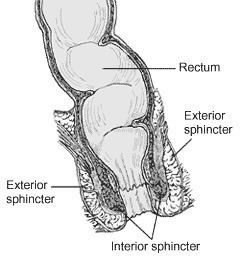 | ||
Defecation is the final act of digestion, by which organisms eliminate solid, semisolid, or liquid waste material from the digestive tract via the anus.
Contents
- Physiology
- Voluntary and involuntary control
- Anal cleansing after defecation
- Posture
- Mythology and tradition
- References
Humans expel feces with a frequency varying from a few times daily to a few times weekly. Waves of muscular contraction (known as peristalsis) in the walls of the colon move fecal matter through the digestive tract towards the rectum. Undigested food may also be expelled this way, in a process called egestion.
Open defecation, the practice of defecating outside without using a toilet of any kind, is still widespread in some developing countries, including, for example, India, Indonesia, Nigeria, and Pakistan.
Physiology
The rectum ampulla (anatomically also: ampulla recti) temporarily stores fecal waste. As the waste fills the rectum and expands the rectal walls, nervous system stretch receptors in the rectal walls stimulate the desire to defecate. This urge to defecate arises from the reflex contraction of rectal muscles, relaxation of the internal anal sphincter, and an initial contraction of the skeletal muscle of the external anal sphincter. If the urge is not acted upon, the material in the rectum is often returned to the colon by reverse peristalsis, where more water is absorbed and the faeces is stored until the next mass peristaltic movement of the transverse and descending colon. If defecation is delayed for a prolonged period the fecal matter may harden, resulting in constipation. If defecation occurs too fast, before excess liquid is absorbed, diarrhea may occur.
When the rectum is full, an increase in intra-rectal pressure forces apart the walls of the anal canal, allowing the fecal matter to enter the canal. The rectum shortens as material is forced into the anal canal and peristaltic waves push the feces out of the rectum. The internal and external anal sphincters along with the puborectalis muscle allow the feces to be passed by muscles pulling the anus up over the exiting feces.
Defecation is normally assisted by taking a deep breath and trying to expel this air against a closed glottis (Valsalva maneuver). This contraction of expiratory chest muscles, diaphragm, abdominal wall muscles, and pelvic diaphragm exerts pressure on the digestive tract. Ventilation at this point temporarily ceases as the lungs push the chest diaphragm down to exert the pressure. Thoracic blood pressure rises and as a reflex response the amount of blood pumped by the heart decreases. Death has been known to occur in cases where defecation causes the blood pressure to rise enough to cause the rupture of an aneurysm or to dislodge blood clots (see thrombosis). Also, in releasing the Valsalva maneuver blood pressure falls; this, coupled with standing up quickly to leave the toilet, can result in a blackout.
During defecation, the external sphincter muscles relax. The anal and urethral sphincter muscles are closely linked. Experiments by Harrison Weed at the Ohio State University Medical Center have shown they can only be contracted together, not individually, and that both show relaxation during urination. This explains why defecation is frequently accompanied by urination.
Voluntary and involuntary control
Defecation may be involuntary or voluntary. Young children learn voluntary control through the process of toilet training. Once trained, loss of control, called fecal incontinence, may be caused by physical injury, nerve injury, prior surgeries (such as an episiotomy), constipation, diarrhea, loss of storage capacity in the rectum, intense fright, inflammatory bowel disease, psychological or neurological factors, childbirth, or death.
Anal cleansing after defecation
The anus and buttocks may be cleansed after defecation with toilet paper, similar paper products, or other absorbent material. In many cultures, such as Hindu and Muslim, water is used for anal cleansing after defecation, either in addition to using toilet paper or exclusively. When water is used for anal cleansing after defecation, toilet paper may be used for drying the area afterwards.
Posture
The positions and modalities of defecation are culture-dependent. Squat toilets are used by the vast majority of the world, including most of Africa, Asia, and the Middle East. The use of sit-down toilets in the Western world is a relatively recent development, beginning in the 19th century with the advent of indoor plumbing.
Mythology and tradition
Some peoples have culturally significant stories in which defecation plays a role. For example:
